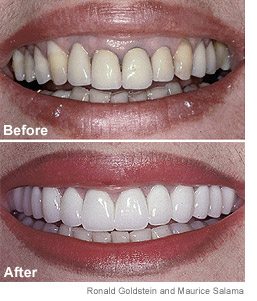By AMIR EFRATI
Staff Reporter of THE WALL STREET JOURNAL
June 29, 2004; Page B1

A 54-year-old woman, unhappy with her initial dental work (top), got a new overhaul (bottom).
“For the patients, it’s a problem—how do you determine who the best cosmetic dentist is?” says California Cosmetic Dentist Larry Addleson, president of the American Academy of Cosmetic Dentistry (AACD).
He says 15% to 20% of the patients in his San Diego practice are victims of poor work. Eric L. Fugier says that at least half the clientele at his Hollywood, Calif., practice come with botched jobs he fixes. For Robert Vogel, a Manhattan dentist who works on celebrities such as Madonna and Nicole Kidman, it is upward of one-fourth.
Experts say that even though further training isn’t mandatory, practitioners should take it upon themselves to boost their education. “To do an entire mouth restoration and crowns is usually out of the scope of recent graduates without more continuing education,” says Dennis Tarnow, professor and chairman of implant dentistry at New York University’s College of Dentistry. For-profit companies offering “continuing medical education” charge dentists as much as $10,000 a course, and business is booming. The Las Vegas Institute for Advanced Dental Studies, for instance, is teaching 600 dentists this year, compared with just 200 four years ago. LVI also offers courses in financial strategies, such as “The Dental Concierge—Developing a CA$H Practice,” according to its Web site. Some dentists are critical of LVI’s commercial bent. “They give the wrong message to the dentist that it’s OK to grind down teeth and sell the patient that their life is going to change and improve,” says Simon Gamer, a dentist in Beverly Hills, Calif. LVI founder and Chief Executive Bill Dickerson disagrees, saying the school trains dentists to be professional and to handle “any situation that comes to the office. We tell them to diagnose the patient’s mouth as if it were your own. “Makers of cosmetic-dental products and laboratories supplying goods to cosmetic dentists say their businesses are expanding at double-digit rates. Da Vinci Studios Inc., a California dental lab that makes customized veneers and crowns for 1,500 dental practices—and whose veneers are featured on the “Extreme Makeover” and “Swan” reality shows—says sales rose 25% last year. MicroDental Laboratories Inc., a Dublin, Calif., lab, had $23 million in revenue from porcelain veneers last year, up from $12 million in 2000.
Patients are paying thousands for a million-dollar smile. Veneers and crowns can range to as much as $4,000 a tooth, and in-office whitening can cost as much as $1,000. That compares with $50 to $250 a tooth for conventional procedures such as cavity fillings.
As a result, dentists’ incomes are soaring. Their average annual income was $173,140 in 2001, the most recent year for which figures are available from the ADA, up from $133,430 in 1997. Larry Winans, a 39-year-old Lewisburg, Pa., dentist who took courses at LVI, says he went from earning about $100,000 in 1999 to more than $200,000 today, mostly because of increased business in cosmetic work. William Dorfman, a Century City, Calif., dentist who is featured on “Extreme Makeover” and who sees 200 new patients each month, says their “dental IQs have skyrocketed” since the show began because now they are aware of the kinds of cosmetic dentistry available. “In the old days, it took a lot of time to explain the procedures,” Dr. Dorfman says. Now, “it’s almost like all I have to do is verify what they want done.” Gordon J. Christensen, a clinical professor at the University of Utah and owner of the for-profit, continuing-education Practical Clinical Courses in Provo, Utah, commented on the rise in incidence of botched work. He says the onus to halt the rise of botched work falls on the ADA, which can recommend additional guidelines for cosmetic dentistry to state and local dental associations. However, the ADA, which represents the vast majority of the more than 155,000 U.S. dentists and advises the dental boards of each state, believes current ADA guidelines and state regulations provide “sufficient oversight for the protection of the public,” says Matt Messina, an ADA consumer adviser and a dentist in Cleveland, Ohio.
Write to Amir Efrati at amir:efrati@dowjones.com
Click here to read Dr. Hall’s blog post about how to ask for a refund from your dentist.
